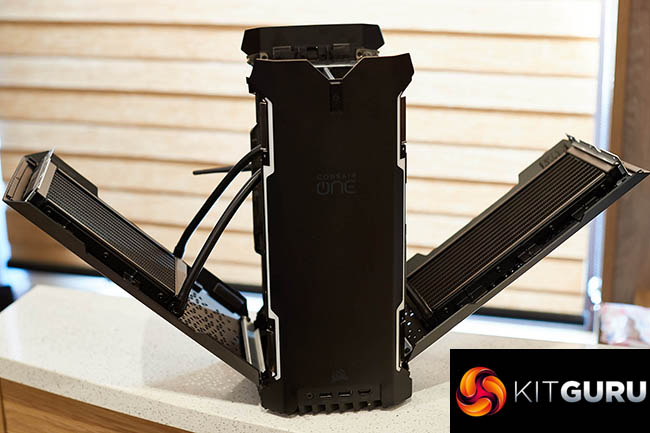The Corsair One has been around in various guises now for some time. The latest models for 2019 are packing the very highest levels of gaming hardware available – the 9700k and 9900k are the best gaming processors on the market today, and the RTX 2080 and RTX 2080 ti are the fastest gaming graphics cards money can buy.

So who would be interested in the Corsair One? Its fair to say by now, if you have read the review you will either hate, or love it. The tech equivalent of marmite. You will likely also admire what Corsair have managed to achieve confined inside such a diminutive chassis.
If you are in the market for a full sized desktop system and don't care about the footprint then this is likely not going to make your shortlist. If you demand a high value for money system, then neither the i140 and i160 are that system.
Personally, I feel they are both great systems. If you are pairing them up with a 1440p 120hz GSYNC monitor then the Corsair One will deliver great frame rates. I would likely opt for the more expensive RTX 2080 ti version – as it gives additional headroom to maintain 100+ frame rates in most of the games I tested.
The system itself is beautifully built and while its going to be hard for many to justify the price overhead, you are paying for the exquisite engineering of the bead blasted aluminum chassis and the fact that the dual AIO coolers on either side of the case manage to deal with the hot running components admirably well. You could buy these components online and put them into a full sized ATX case for substantially less money, but I feel thats somewhat missing the point.
The Corsair One has been designed for the end user who wants a small chassis, with a tiny footprint that can easily be placed on a desk beside a keyboard or behind a monitor. It has been tweaked to emit very low levels of noise, even under sustained load. At the default fan setting, I barely even knew it was turned on most of the time and considering the immense gaming performance, that is quite an achievement in itself.
Overclocking the system proved quite easy, and if you aren't comfortable with doing it all yourself, then the latest Intel Performance Maximiser tool works perfectly well with both i140 and i160 systems I have been using for the last month. It takes about an hour to complete, and depending on the silicon lottery you are likely to end up with around an extra 10% performance from the processors. Both RTX 2080 and RTX 2080ti graphics cards responded well to MSI's Afterburner tool and the heat levels didn't rise that much either.
While you can customise these systems yourself, its not what we would consider an easy process. Changing the top fan to a more powerful Corsair ML140 Pro will enhance the cooling – as this fan increases the maximum speeds from 1,600 rpm to 2,000 rpm (at the expense of a little extra noise). Removing the ill performing 2TB 5,400 rpm hard drive is again, straightforward enough. However changing the power supply or putting in a different graphics card is quite a bit more involved.
Corsair really should have opted for all SSD storage in these systems – replacing the 2TB mechanical drive with a 1TB SSD – it wouldn't have cost Corsair much more and it seems penny pinching to the extreme. The 480GB boot drive is very quick, but I would not be using it for my game installs, as it will fill up pretty quickly.
As I mentioned earlier in this article, the Seagate 5,400 rpm drive is terrible to install a STEAM library onto. Its painfully slow and grinds to a halt when big game installers are decrypting and expanding. I would only use this drive for file backups, installers, images and work documents. I got around the ill performing mechanical drive by hooking up a 2TB Samsung 860 Pro inside an external enclosure. It transformed the experience. But thats even more money and a little slap in the face after spending so much in the first place.
You can buy the Corsair i140 from Amazon for £2849.99 HERE
You can buy the Corsair i160 from Amazon for £3399.99 HERE
As I mentioned earlier in the review, If neither of these systems is powerful enough for you, then be sure to check out the Corsair ONE i180 (HERE), with Core i9 9920X, RTX 2080 ti and 960GB NVMe SSD – although you still get the terrible 2TB 5,400 rpm HDD – and all for £4,749.99.
In closing, the 2TB 5,400 RPM HDD is the only reason these systems didn't get our highest award today. Next time Corsair – all SSD storage please – its 2019.
Pros:
- Incredible Performance.
- Very Quiet.
- Looks fantastic.
- Tiny footprint.
- RGB lighting looks great.
- iCue software allows for custom profiles.
Cons:
- 2TB 5,400 rpm storage drive is shocking to see.
- Expensive.
- Not easy to upgrade.
KitGuru says: The Corsair i140 and i160 perform to the highest levels, they are quiet, and look incredible. Its for a niche audience, but Corsair have nailed the thermals and created something utterly unique in a very saturated market.
Be sure to check out our sponsors store EKWB here
 KitGuru KitGuru.net – Tech News | Hardware News | Hardware Reviews | IOS | Mobile | Gaming | Graphics Cards
KitGuru KitGuru.net – Tech News | Hardware News | Hardware Reviews | IOS | Mobile | Gaming | Graphics Cards



